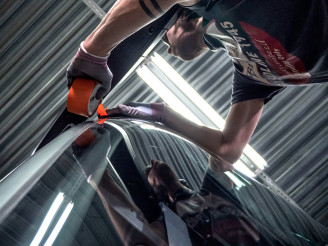Replacing an old windscreen
Windscreen replacement is a process that involves several steps. Whether the replacement was carried out successfully is determined by means of a final water test. This test ensures that the end result is watertight and the work has been completed to a high standard.
The first step is to protect the bodywork around the windscreen. The outside seams of the windscreen are then opened, and the glue that attaches the windscreen to the bodywork is cut with a corner blade. The old windscreen is then ready to be removed. Any remaining glue and other residues can now be removed; this is necessary to ensure that the new windscreen will be seated correctly and attached firmly to the bodywork. The windscreen is part of the load-bearing structure of the body, and it is subjected to significant forces.
The preparations for the installation of the new windscreen can now begin. The frame is treated with a primer to ensure the adhesion and bond strength of the glue. The new windscreen is cleaned thoroughly before installation since all parts of the windscreen – especially the inside corners – are easily accessible at this point. A new bead of glue is applied to the frame, and the new windscreen is fitted in place. How well the windscreen fits depends on the vehicle. This step reveals the precision and accuracy of the manufacturing process. There is always some leeway, but the windscreen must not be bent, it must not be in direct contact with the frame and it must not be under tension. Otherwise it will crack when the vehicle hits the first bump or pothole.
After gluing, the windscreen is supported and the glue for the outside seams is applied. All of this is then left to dry for a few hours. After the waiting time is over, the finishing steps and final cleaning are carried out and the windscreen wipers are reinstalled. We also often install a stone chip protection film at the bottom of the windscreen because this is the part most likely to be hit by debris. The film will prevent the windscreen from chipping. Then we use a hose to spray the windscreen with plenty of water to make sure that it is tight. If everything is fine, the vehicle is ready to roll.
